Large-Area Thickness Measurement of Transparent Films Based on a Multichannel Spectral Interference Sensor
Abstract
Featured Application
Abstract
1. Introduction
2. Methods
2.1. Basic Principle
2.2. Calculation Method
2.3. Hardware Configuration
3. Experiments and Discussion
3.1. Standard Film Samples Measurement
3.2. Thickness Measurement of Polyimide Films
3.3. Multilayer Films Measurement
3.4. Large-Area Thickness Measurement
4. Conclusions
Author Contributions
Funding
Data Availability Statement
Conflicts of Interest
References
- ElKabbash, M.; Letsou, T.; Jalil, S.A.; Hoffman, N.; Zhang, J.H.; Rutledge, J.; Lininger, A.R.; Fann, C.H.; Hinczewski, M.; Strangi, G.; et al. Fano-resonant ultrathin film optical coatings. Nat. Nanotechnol. 2021, 16, 440–446. [Google Scholar] [CrossRef] [PubMed]
- Shi, J.L.; Zhang, J.Y.; Yang, L.; Qu, M.; Qi, D.C.; Zhang, K.H.L. Wide Bandgap Oxide Semiconductors: From Materials Physics to Optoelectronic Devices. Adv. Mater. 2021, 33, 2006230. [Google Scholar] [CrossRef] [PubMed]
- Mondal, S.; Yoshida, T.; Maji, S.; Ariga, K.; Higuchi, M. Transparent Supercapacitor Display with Redox-Active Metallo-Supramolecular Polymer Films. ACS Appl. Mater. Interfaces 2020, 12, 16342–16349. [Google Scholar] [CrossRef] [PubMed]
- Jin, Y.; Yu, K. A review of optics-based methods for thickness and surface characterization of two-dimensional materials. J. Phys. D-Appl. Phys. 2021, 54, 393001. [Google Scholar] [CrossRef]
- Oh, S.J.; Kwon, J.H.; Lee, S.; Choi, K.C.; Kim, T.S. Unveiling the Annealing-Dependent Mechanical Properties of Freestanding Indium Tin Oxide Thin Films. ACS Appl. Mater. Interfaces 2021, 13, 16650–16659. [Google Scholar] [CrossRef] [PubMed]
- Chauhan, R.N.; Tiwari, N. Preparation of optically transparent and conducting radio-frequency sputtered indium tin oxide ultrathin films. Thin Solid Film. 2021, 717, 138471. [Google Scholar] [CrossRef]
- Butt, M.A. Thin-Film Coating Methods: A Successful Marriage of High-Quality and Cost-Effectiveness—A Brief Exploration. Coatings 2022, 12, 1115. [Google Scholar] [CrossRef]
- Benrezgua, E.; Deghfel, B.; Zoukel, A.; Basirun, W.J.; Amari, R.; Boukhari, A.; Yaakob, M.K.; Kheawhom, S.; Mohamad, A.A. Synthesis and properties of copper doped zinc oxide thin films by sol-gel, spin coating and dipping: A characterization review. J. Mol. Struct. 2022, 1267, 133639. [Google Scholar] [CrossRef]
- Akhtar, A.; Ruan, H.H. Review on thin film coatings for precision glass molding. Surf. Interfaces 2022, 30, 101903. [Google Scholar] [CrossRef]
- Dou, P.; Jia, Y.; Zheng, P.; Wu, T.; Yu, M.; Reddyhoff, T.; Peng, Z. Review of ultrasonic-based technology for oil film thickness measurement in lubrication. Tribol. Int. 2022, 165, 107290. [Google Scholar] [CrossRef]
- Dou, P.; Wu, T.; Peng, Z. A time-domain ultrasonic approach for oil film thickness measurement with improved resolution and range. Meas. Sci. Technol. 2020, 31, 075006. [Google Scholar] [CrossRef]
- Wei, S.J.; Wang, J.R.; Cui, J.; Song, S.S.; Li, H.C.; Fu, J.F. Online monitoring of oil film thickness of journal bearing in aviation fuel gear pump. Measurement 2022, 204, 112050. [Google Scholar] [CrossRef]
- Chen, Z.Q.; Chen, J.J.; Shu, S.B.; Yu, Z.Q.; Zhang, Y.Z.; Tao, X.J.; Lang, X.L. Oil Scale Profile Detection in Oil Pipeline Based on Improved Gamma-Ray Scanning Transmission Method. Nucl. Sci. Eng. 2022, 196, 1255–1265. [Google Scholar] [CrossRef]
- Kim, K.J. Review on the thickness measurement of ultrathin oxide films by mutual calibration method. Surf. Interface Anal. 2022, 54, 405–416. [Google Scholar] [CrossRef]
- Giurlani, W.; Berretti, E.; Innocenti, M.; Lavacchi, A. Measuring the Thickness of Metal Coatings: A Review of the Methods. Coatings 2020, 10, 1211. [Google Scholar] [CrossRef]
- Im, K.H.; Kim, S.K.; Cho, Y.T.; Woo, Y.D.; Chiou, C.P. THz-TDS Techniques of Thickness Measurements in Thin Shim Stock Films and Composite Materials. Appl. Sci. 2021, 11, 8889. [Google Scholar] [CrossRef]
- Krimi, S.; Klier, J.; Jonuscheit, J.; von Freymann, G.; Urbansky, R.; Beigang, R. Highly accurate thickness measurement of multi-layered automotive paints using terahertz technology. Appl. Phys. Lett. 2016, 109, 021105. [Google Scholar] [CrossRef]
- Su, K.; Shen, Y.-C.; Zeitler, J.A. Terahertz Sensor for Non-Contact Thickness and Quality Measurement of Automobile Paints of Varying Complexity. IEEE Trans. Terahertz Sci. Technol. 2014, 4, 432–439. [Google Scholar] [CrossRef]
- Grau-Luque, E.; Guc, M.; Becerril-Romero, I.; Izquierdo-Roca, V.; Pérez-Rodríguez, A.; Bolt, P.; Van den Bruele, F.; Ruhle, U. Thickness evaluation of AlOx barrier layers for encapsulation of flexible PV modules in industrial environments by normal reflectance and machine learning. Prog. Photovolt. 2022, 30, 229–239. [Google Scholar] [CrossRef]
- Lee, S.W.; Lee, S.Y.; Choi, G.; Pahk, H.J. Co-axial spectroscopic snap-shot ellipsometry for real-time thickness measurements with a small spot size. Opt. Express 2020, 28, 25879–25893. [Google Scholar] [CrossRef]
- Liu, J.; Zhang, D.; Yu, D.; Ren, M.; Xu, J. Machine learning powered ellipsometry. Light-Sci. Appl. 2021, 10, 55. [Google Scholar] [CrossRef]
- Yang, K.J.; Han, C.H.; Feng, J.H.; Tang, Y.; Xie, Z.Y.; Hu, S. Film Thickness-Profile Measurement Using Iterative Peak Separation Structured Illumination Microscopy. Appl. Sci. 2021, 11, 3023. [Google Scholar] [CrossRef]
- Xie, Z.; Tang, Y.; Zhou, Y.; Deng, Q. Surface and thickness measurement of transparent thin-film layers utilizing modulation-based structured-illumination microscopy. Opt. Express 2018, 26, 2944–2953. [Google Scholar] [CrossRef] [PubMed]
- Bai, J.; Li, J.W.; Wang, X.H.; Zhou, Q.; Ni, K.; Li, X.H. A new method to measure spectral reflectance and film thickness using a modified chromatic confocal sensor. Opt. Lasers Eng. 2022, 154, 107019. [Google Scholar] [CrossRef]
- Ganesan, A.R.; Mani, A.; Maliackal, A.K. Heat transfer enhanced surfaces for horizontal tube falling film evaporator characterized using laser interferometry. Appl. Therm. Eng. 2022, 210, 118303. [Google Scholar]
- Guo, T.; Zhao, G.H.; Tang, D.W.; Weng, Q.W.; Sun, C.B.; Gao, F.; Jiang, X.Q. High-accuracy simultaneous measurement of surface profile and film thickness using line-field white-light dispersive interferometer. Opt. Lasers Eng. 2021, 137, 106388. [Google Scholar] [CrossRef]
- Lu, X.; Yuan, Y.G.; Ma, C.; Zhu, H.B.; Zhu, Y.L.; Yu, Z.J.; Zhang, X.J.; Jiang, F.Q.; Zhang, J.Z.; Li, H.Y.; et al. Self-Calibrated Absolute Thickness Measurement of Opaque Specimen Based on Differential White Light Interferometry. IEEE Trans. Instrum. Meas. 2020, 69, 2507–2514. [Google Scholar] [CrossRef]
- Bae, J.; Park, J.; Ahn, H.; Jin, J. Optical method for simultaneous thickness measurements of two layers with a significant thickness difference. Opt. Express 2021, 29, 31615–31631. [Google Scholar] [CrossRef]
- Lee, J.; Jin, J. Thickness and refractive index measurements of a thin-film using an artificial neural network algorithm. Metrologia 2023, 60, 025001. [Google Scholar] [CrossRef]
- Sanchez-Arriaga, N.E.; Tiwari, D.; Hutabarat, W.; Leyland, A.; Tiwari, A. A Spectroscopic Reflectance-Based Low-Cost Thickness Measurement System for Thin Films: Development and Testing. Sensors 2023, 23, 5326. [Google Scholar] [CrossRef]
- Hao, R.; Zhu, L.L.; Li, Z.X.; Fang, F.Z.; Zhang, X.D. A Miniaturized and Fast System for Thin Film Thickness Measurement. Appl. Sci. 2020, 10, 7284. [Google Scholar] [CrossRef]
- Minkov, D.; Marquez, E.; Angelov, G.; Gavrilov, G.; Ruano, S.; Saugar, E. Further Increasing the Accuracy of Characterization of a Thin Dielectric or Semiconductor Film on a Substrate from Its Interference Transmittance Spectrum. Materials 2021, 14, 4681. [Google Scholar] [CrossRef] [PubMed]
- Nečas, D.; Vodák, J.; Ohlídal, I.; Ohlídal, M.; Majumdar, A.; Zajíčková, L. Simultaneous determination of dispersion model parameters and local thickness of thin films by imaging spectrophotometry. Appl. Surf. Sci. 2015, 350, 149–155. [Google Scholar] [CrossRef]
- Xue, K.J.; Wang, J.S.; Zhao, Y.Y.; Xiao, Z.J. Measurement of glass thickness and refractive index based on spectral interference technology. Appl. Opt. 2021, 60, 7983–7988. [Google Scholar] [CrossRef] [PubMed]
- Nemoto, F. Thickness and birefringence of thin films assessed by interferometry using a low-cost spectrometer. Spectrosc. Lett. 2021, 54, 707–714. [Google Scholar] [CrossRef]
- Cheng, X.L.; Tang, Y.; Yang, K.J.; Han, C.H.L. Deep Learning for Thin Film Thickness Measurement in Spectroscopic Reflectometry. IEEE Photonics Technol. Lett. 2022, 34, 969–972. [Google Scholar] [CrossRef]
- Vanderplas, J.T. Understanding the Lomb–Scargle Periodogram. Astrophys. J. Suppl. Ser. 2018, 236, 16. [Google Scholar] [CrossRef]
- Zha, J.-W.; Wang, F. Research progress of high thermal conductivity polyimide dielectric films. Acta Phys. Sin. 2022, 71, 233601. [Google Scholar] [CrossRef]
- Wang, Y.; Zhang, X.; Xiao, C.; Ding, X.; Zheng, K.; Liu, X.; Gong, Y.; Chen, L.; Tian, X. Research Progress of Polyimide Based Thermally Conductive Insulating Composite Film. Polym. Bull. 2023, 36, 1015–1026. [Google Scholar]
- Zha, J.; Liu, X.; Dong, X.; Wan, B. Research Progress of Dielectric Polyimide Films. Polym. Bull. 2023, 36, 998–1014. [Google Scholar]
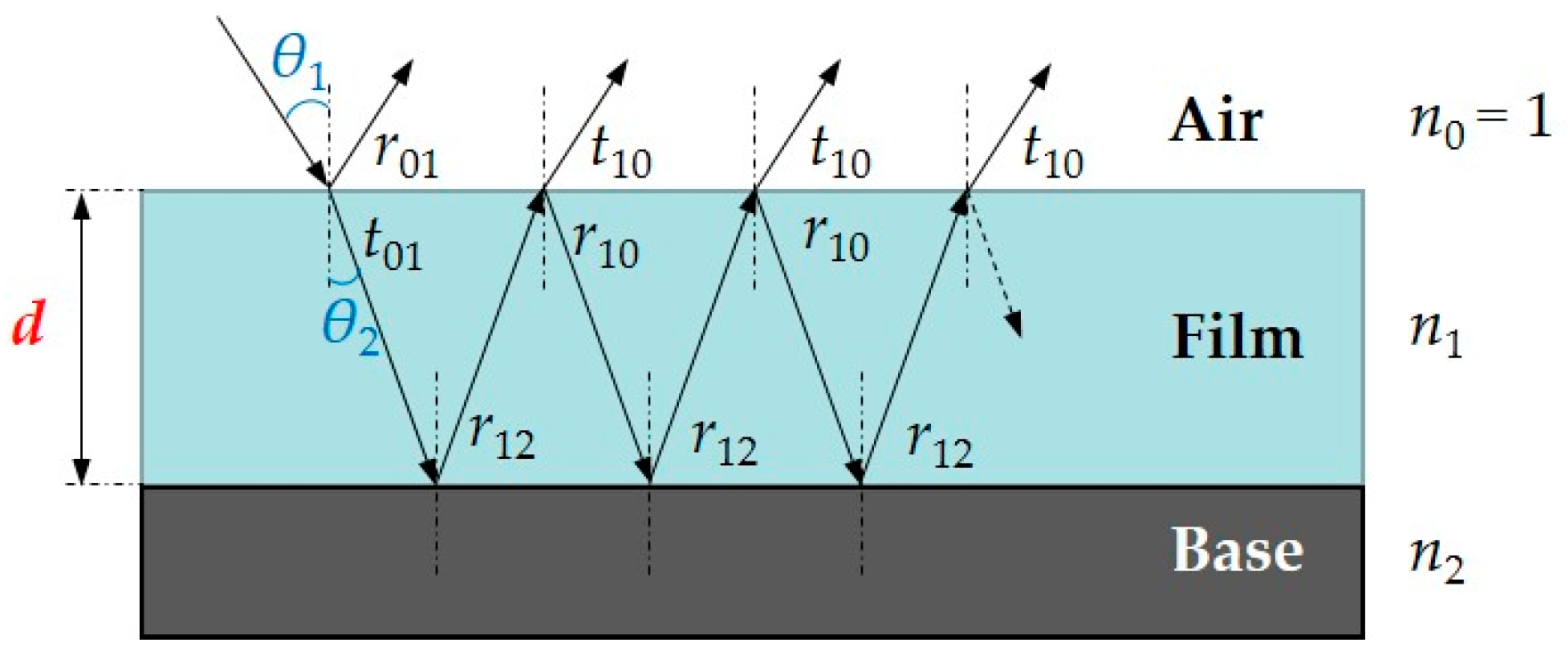
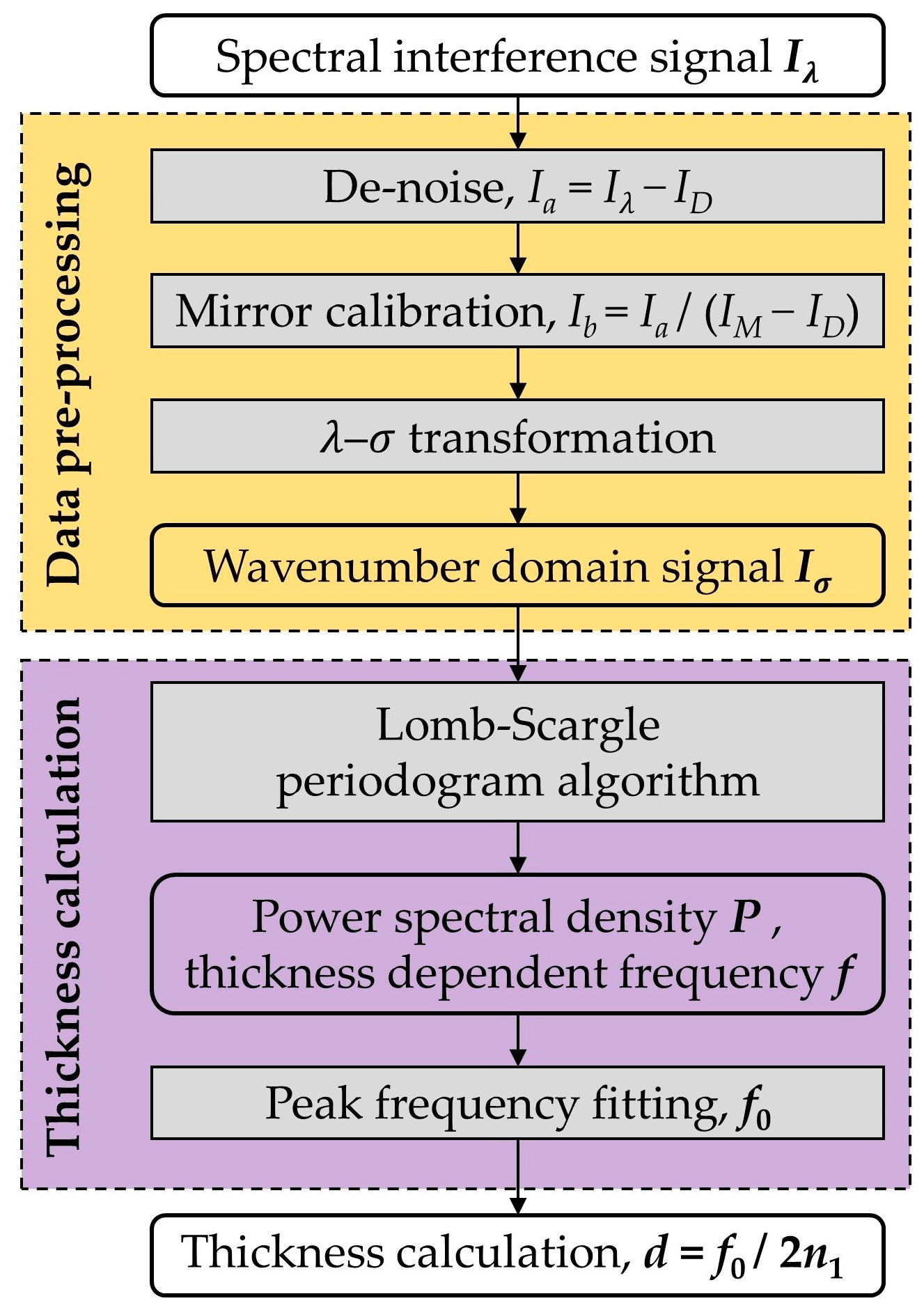


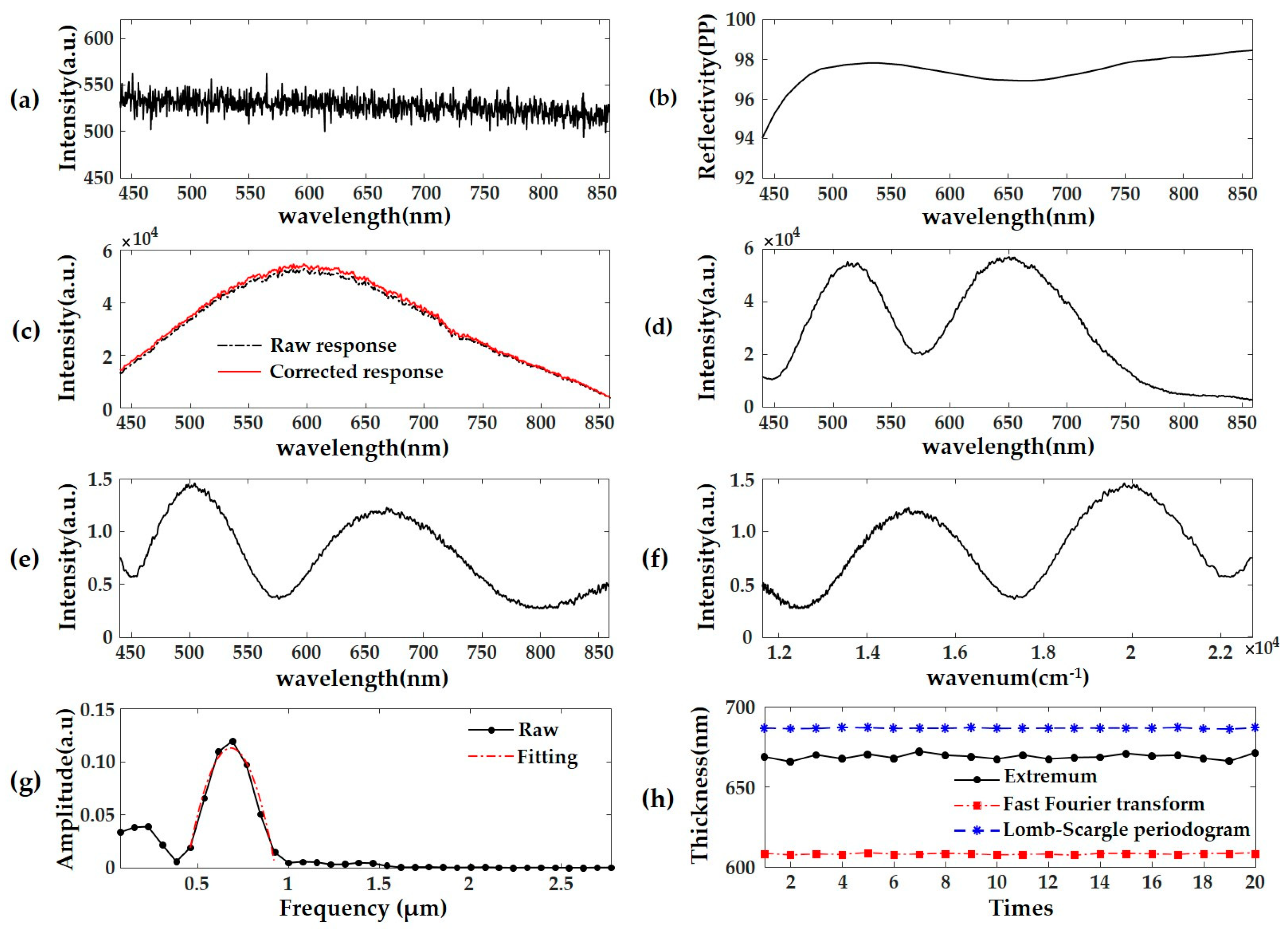
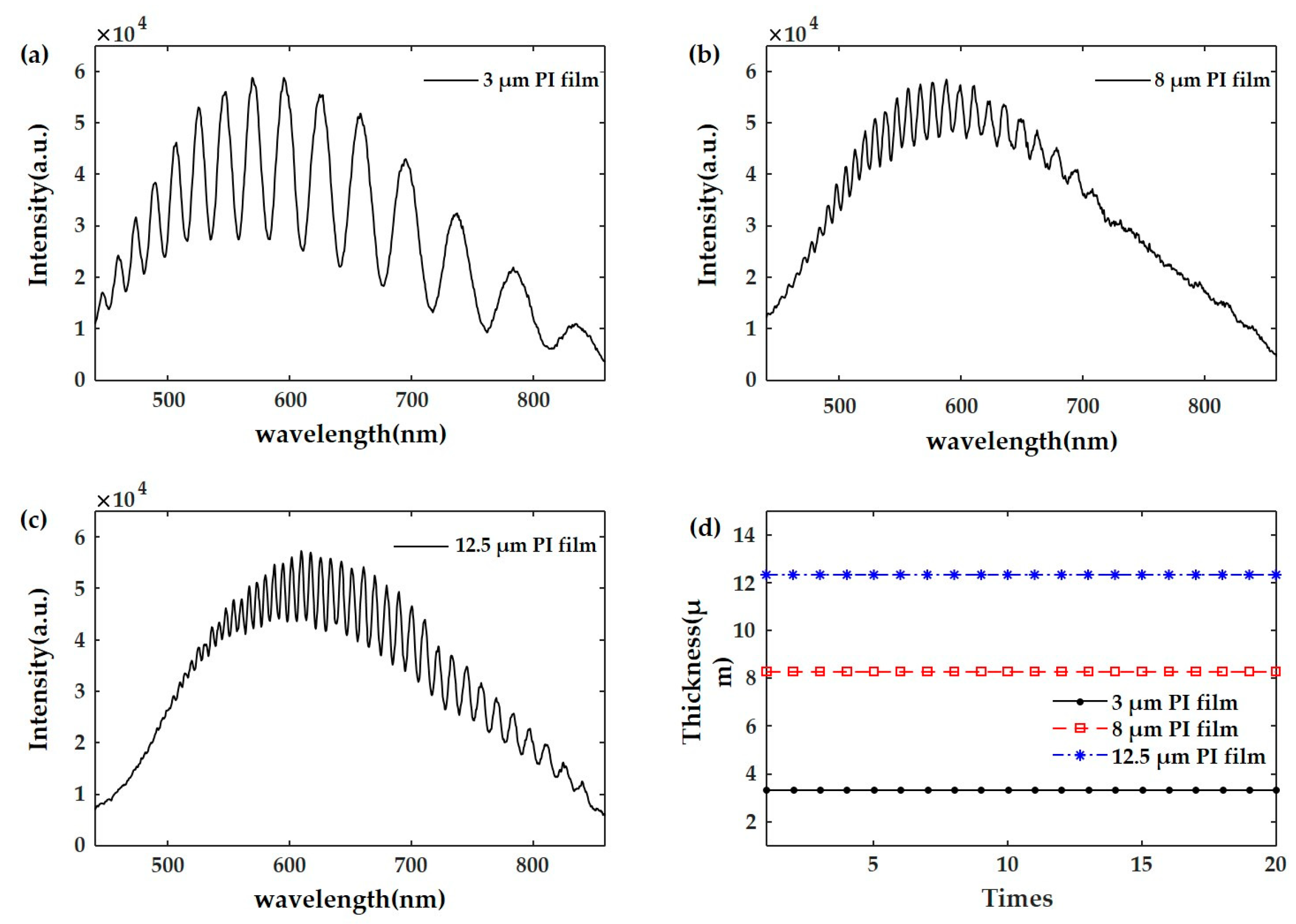
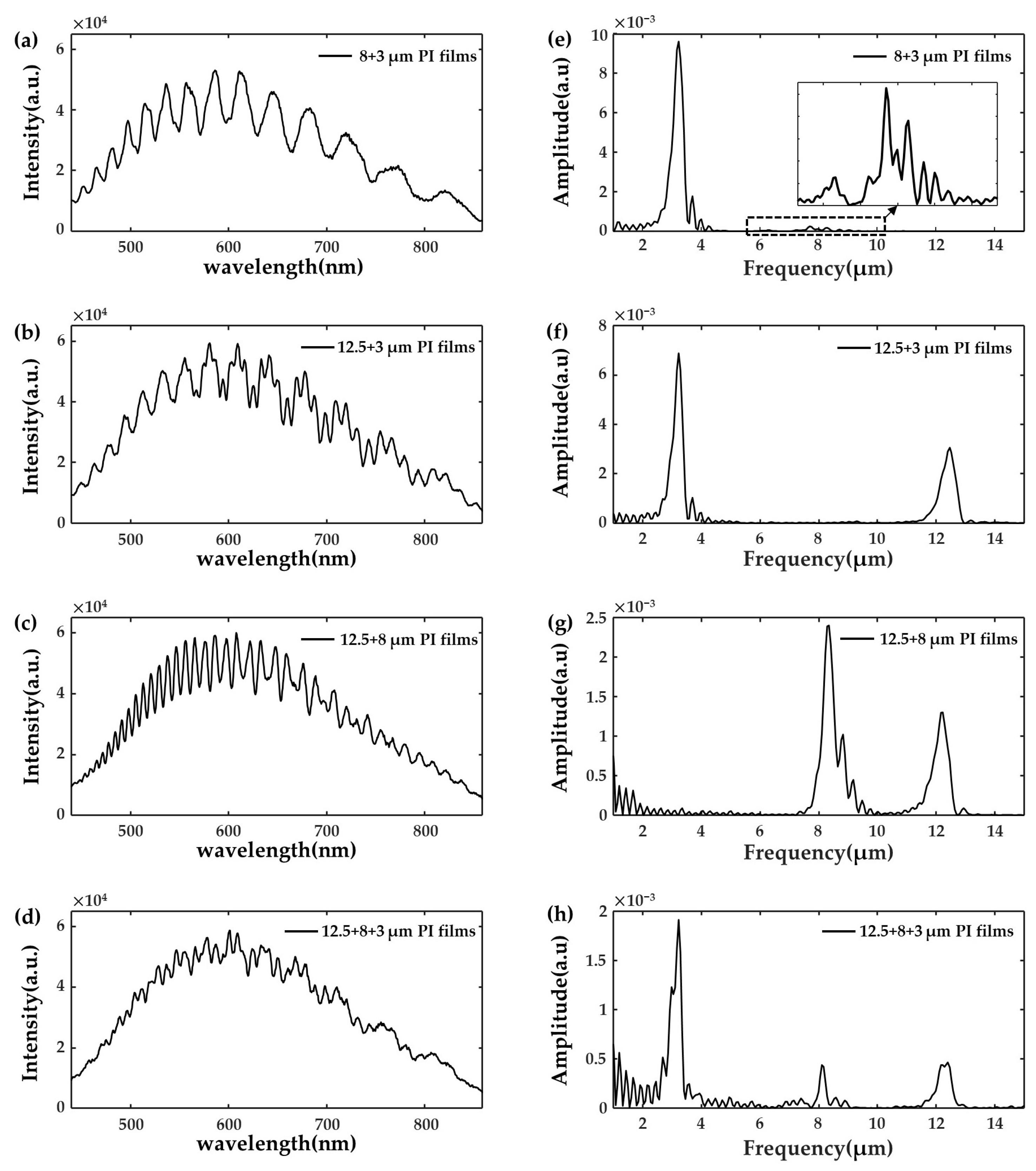
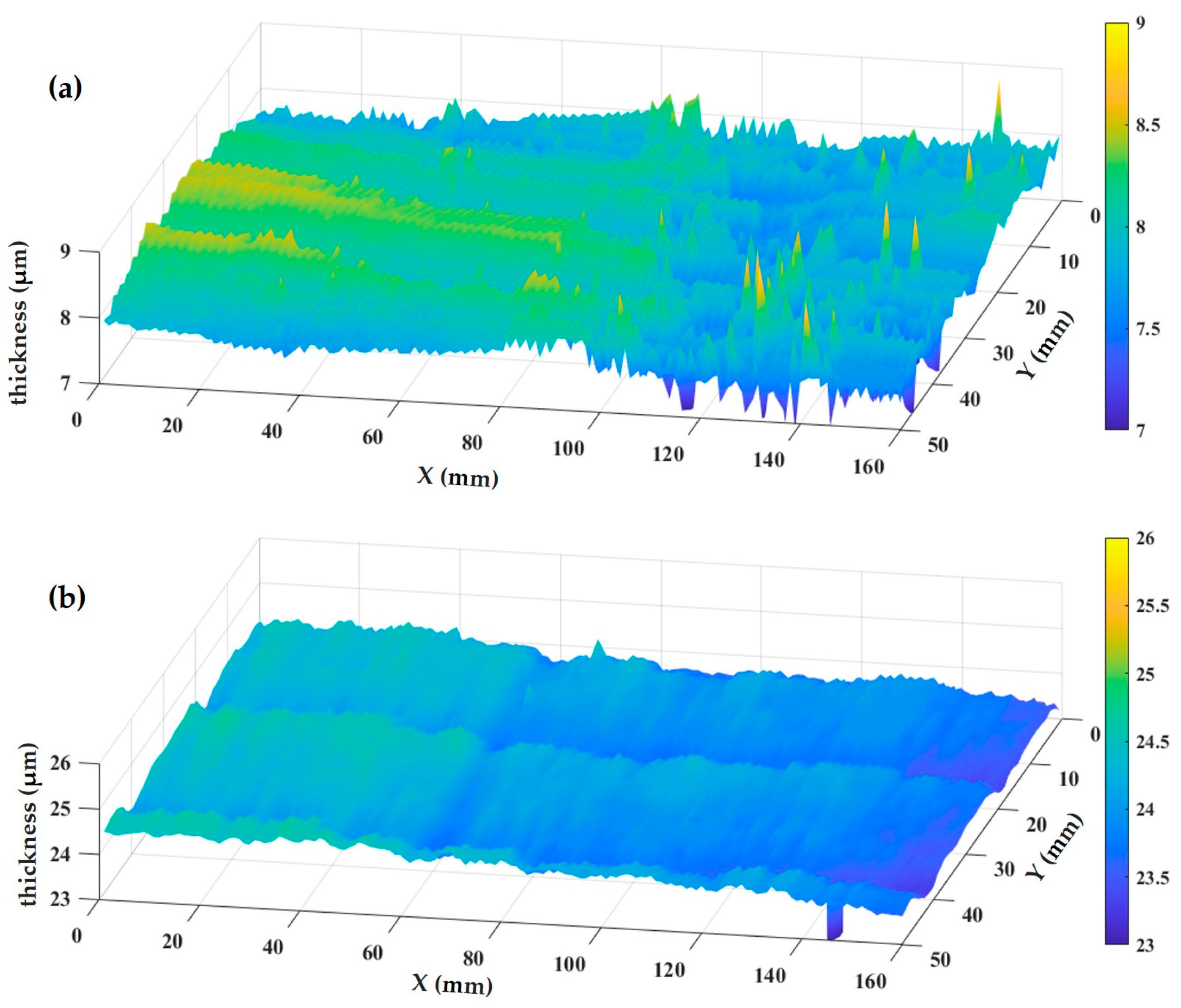
| Method | Mean Value (nm) | Deviation (nm) | Std (nm) | Time (ms) |
|---|---|---|---|---|
| Extremum | 668.65 | −20.48 | 1.65 | 0.02 |
| Fast Fourier transform | 607.91 | −81.22 | 0.26 | 0.06 |
| Proposed method | 686.52 | −2.61 | 0.27 | 1.17 |
| Channel | SiO2 | Parylene | ||||
|---|---|---|---|---|---|---|
| Thickness (nm) | Deviation (nm) | Std (nm) | Thickness (nm) | Deviation (nm) | Std (nm) | |
| 1 | 686.52 | −2.61 | 0.27 | 7150.9 | −15.1 | 1.0 |
| 2 | 688.43 | −0.70 | 0.29 | 7152.9 | −13.1 | 0.9 |
| 3 | 687.81 | −1.32 | 0.30 | 7156.0 | −10.0 | 0.7 |
| 4 | 686.54 | −2.59 | 0.29 | 7163.5 | −2.5 | 1.1 |
| Combination | Thickness (μm) | Std (nm) | ||||
|---|---|---|---|---|---|---|
| 3 μm | 8 μm | 12.5 μm | 3 μm | 8 μm | 12.5 μm | |
| 8 + 3 | 3.2198 | 7.7106 | / | 2.9 | 11.8 | / |
| 12.5 + 3 | 3.2097 | / | 12.4534 | 1.4 | / | 5.5 |
| 12.5 + 8 | / | 8.3303 | 12.2097 | / | 11.4 | 16.6 |
| 12.5 + 8 + 3 | 3.1804 | 8.1202 | 12.3221 | 4.1 | 14.6 | 19.8 |
Disclaimer/Publisher’s Note: The statements, opinions and data contained in all publications are solely those of the individual author(s) and contributor(s) and not of MDPI and/or the editor(s). MDPI and/or the editor(s) disclaim responsibility for any injury to people or property resulting from any ideas, methods, instructions or products referred to in the content. |
© 2024 by the authors. Licensee MDPI, Basel, Switzerland. This article is an open access article distributed under the terms and conditions of the Creative Commons Attribution (CC BY) license (https://creativecommons.org/licenses/by/4.0/).
Share and Cite
Huang, W.; Tu, Z.; Di, Z.; Wang, C.; Su, Y.; Bi, H. Large-Area Thickness Measurement of Transparent Films Based on a Multichannel Spectral Interference Sensor. Appl. Sci. 2024, 14, 2816. https://doi.org/10.3390/app14072816
Huang W, Tu Z, Di Z, Wang C, Su Y, Bi H. Large-Area Thickness Measurement of Transparent Films Based on a Multichannel Spectral Interference Sensor. Applied Sciences. 2024; 14(7):2816. https://doi.org/10.3390/app14072816
Chicago/Turabian StyleHuang, Weihua, Zhengqian Tu, Zixiang Di, Chenhui Wang, Yunhao Su, and Hai Bi. 2024. "Large-Area Thickness Measurement of Transparent Films Based on a Multichannel Spectral Interference Sensor" Applied Sciences 14, no. 7: 2816. https://doi.org/10.3390/app14072816
APA StyleHuang, W., Tu, Z., Di, Z., Wang, C., Su, Y., & Bi, H. (2024). Large-Area Thickness Measurement of Transparent Films Based on a Multichannel Spectral Interference Sensor. Applied Sciences, 14(7), 2816. https://doi.org/10.3390/app14072816






